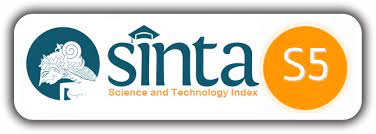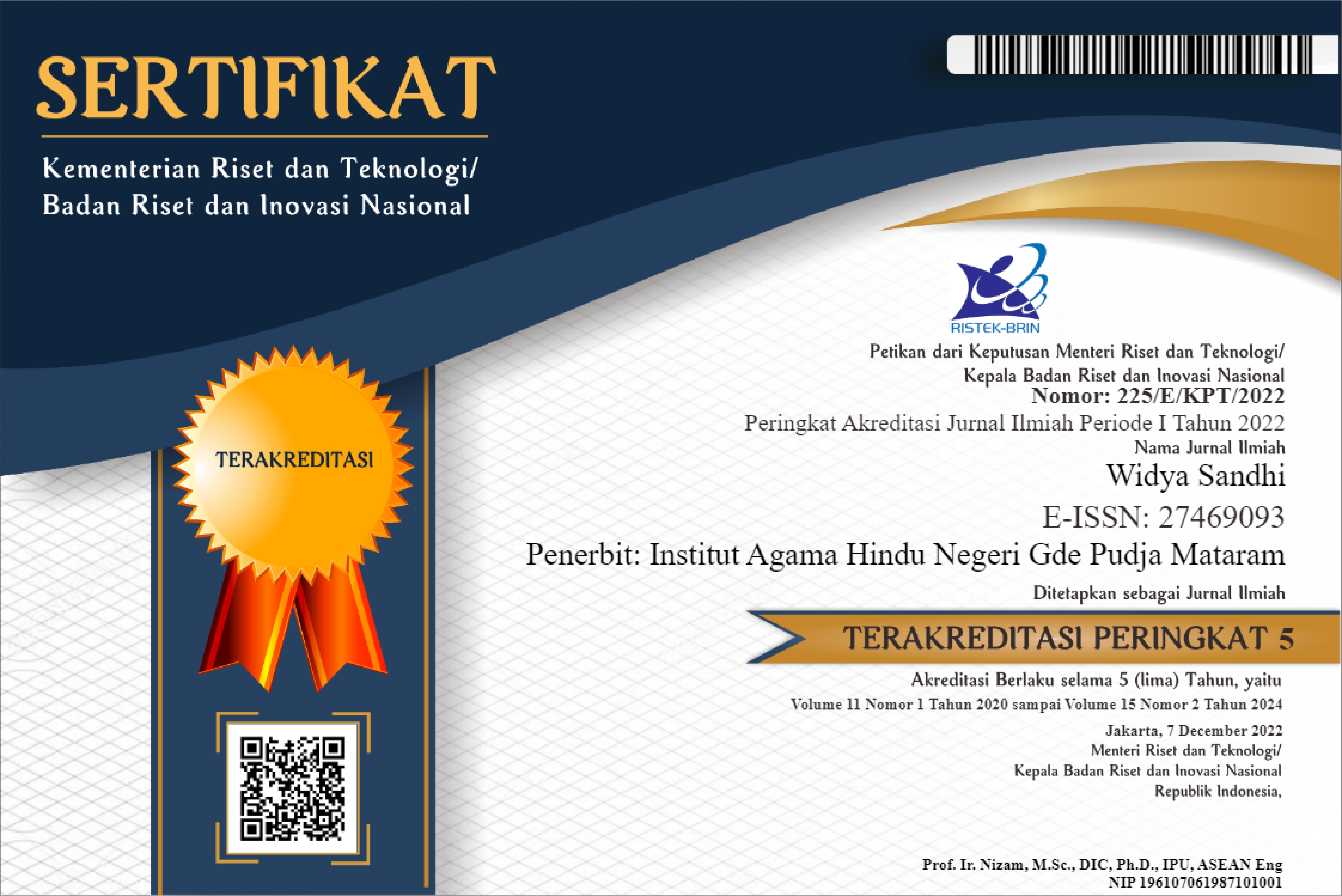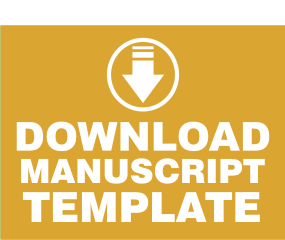Banten Jejanganan dalam Upacara Tiga Bulanan di Kota Mataram
Abstract
Banten jejanganan was used in tiga bulanan ceremony by Hindus in Mataram City. It has been a tradition until now, but Hindus do not fully know and understand its form, function, and meaning. This research aimed at obtaining answers to this matter. It used a descriptive qualitative approach. The research was conducted in Mataram City. The data were collected by observation, interview, and study of document. Data were analyzed by using data reduction, classification and data display, conclusion, and verification. The research findings were: 1) the form of Banten jejanganan in tiga bulanan ceremony in Mataram City was a unified form consisting of various elements; the banten arranged by appropriate process, 2) the functions of the banten jejanganan were as a form of offering to Ida Sang Hyang Widhi (God) and His Manifestations as the sang catur sanak; sang catur sanak had functions in protecting, guarding the baby from the womb until the baby gave birth in the world safely and healthily; catur sanak was also as purification for the baby her/himself and also as the purification to baby’s parents. 3) The meaning of banten jejanganan was a symbol of sacred power of the existence of Ida Sang Hyang Widhi as the Almighty, banten jejanganan had meaning as a symbol of thanks to God for His blessings; it also had meaning as symbol of thanks to catur sanak for taking care the baby. The birth of baby cannot be separated from the support of the parents in guarding, caring for, and carrying out this ceremony by upakara yadnya.
References
Arwati, Sri Ni Made.1999. Upacara Upakara. Denpasar : Upada Sastra.
Azwar, Saefudin,1998. Metode Penelitian.Yogyakarta : Pustaka Belajar.
Budha, Gautama Wayan, 2009. Kamus Bahasa Bali (Bali-Indonesia). Surabaya: Paramita.
Bungin, Burhan, 2007. Penelitian Kualitatif. Jakarta : Kencana Prenada Media Group.
Daryanto, 1997. Kamus Bahasa Indonesia Lengkap. Surabaya : Apollo.
Departemen Pendidikan & Kebudayaan, 2002. Kamus Besar Bahasa Indonesia Edisi III. Jakarta : Balai Pustaka.
Dinas Pendidikan Dasar Propinsi Dati I Bali, 1988. Kamus Kawi-Bali.
Fajri, Em Zul dan Ratu Aprilia Senja, Tth. Kamus Lengkap. Bahasa Indonesia Difa Publisher.
Juniawan, Heri, IB. 2019. Alih Aksara Purwaka Weda.
Kaelan, 2005. Metode Penelitian Kualitatif Bidang Filsafat. Yogyakarta: Paradigma.
Koentjaraningrat, 2002. Pengantar Antropologi Pokok-Pokok Etnografi II. Jakarta : PT Rinika Cipta.
Maleong, Lexy J., 2002. Metode Penelitian Kualitatif, Bandung: Remaja Rosda Karya.
Margono, S. 2004. Metode Penelitian Pendidikan. Jakarta : PT. Rineka Cipta.
Mas, Ny..Mt. Putra. 1993. Panca Yadnya. Jakarta : Yayasan Dharma Sarathi.
Nasir, Moh.1998. Metodologi Penelitian. Jakarta : Rajawali Press.
Ngurah, I Gusti Made dkk, 1999. Buku Pendidikan Agama Hindu Untuk Perguruan Tinggi. Surabaya:Paramita.
Riyanto, Yatim, 2007. Metodologi Penelitian Pendidikan Kualitatif dan Kuantitatif. Surabaya : Unesa University Press.
Singarimbun, Masri dan S. Efendi. 1995. Metode Penelitian Survai. Jakarta : LP3ES.
Suprayogo, Imam 2001. Metodelogi Penelitian Sosial Agama. Bandung : Remaja Rosda Karya.
Suprayogo, Iman dan Tobroni, 2001. Metodologi Penelitian Sosial-Agama, Bandung: Remaja Rosdakarya.
Surayin, Ida Ayu Putu, 2004. Melangkah Kearah Persiapan Upakara Upacara Yajna. Surabaya : Paramita.
Tim Penyusun, 2008. Panca Yajna. Denpasar: Widya Dharma.

This work is licensed under a Creative Commons Attribution-NonCommercial-ShareAlike 4.0 International License.
Authors who publish with this journal agree to the following terms:
- Authors retain copyright and grant the journal right of first publication with the work simultaneously licensed under a Creative Commons Attribution-ShareAlike 4.0 International License. that allows others to share the work with an acknowledgment of the work's authorship and initial publication in this journal.
- Authors are able to enter into separate, additional contractual arrangements for the non-exclusive distribution of the journal's published version of the work (e.g., post it to an institutional repository or publish it in a book), with an acknowledgment of its initial publication in this journal.
- Authors are permitted and encouraged to post their work online (e.g., in institutional repositories or on their website) prior to and during the submission process, as it can lead to productive exchanges, as well as earlier and greater citation of published work (See The Effect of Open Access).






.jpg)




